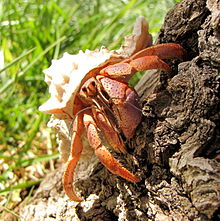| Caribbean hermit crab | |
|---|---|

| |
| Scientific classification | |
| Domain: | Eukaryota |
| Kingdom: | Animalia |
| Phylum: | Arthropoda |
| Class: | Malacostraca |
| Order: | Decapoda |
| Suborder: | Pleocyemata |
| Infraorder: | Anomura |
| Family: | Coenobitidae |
| Genus: | Coenobita |
| Species: | C. clypeatus |
| Binomial name | |
| Coenobita clypeatus (Fabricius, 1787) | |

The Caribbean hermit crab (Coenobita clypeatus), also known as the soldier crab, West Atlantic crab, tree crab, or purple pincher (due to the distinctive purple claw), is a species of land hermit crab native to the west Atlantic, Belize, southern Florida, Venezuela, and the West Indies.
Description
Adults burrow and hide under the roots of large trees, and can be found a considerable distance inland. As with other terrestrial decapods, they use modified gills to breathe air. Their shells help maintain the humidity necessary for gas exchange to function. Typically, the Caribbean hermit crab's left claw is larger in size than its right claw and is purple in color. Female land hermit crabs release fertilized eggs into the ocean. The spawning (called "washing" in the English-speaking Caribbean) occurs on certain nights, usually around August.
Ecology
Caribbean hermit crabs are both herbivorous and scavengers. In the wild, C. clypeatus feeds on animal and plant remains, overripe fruit, and faeces of other animals, including the Mona ground iguana (Cyclura stejnegeri). The West Indian top snail (Cittarium pica) shell is often used for its home, and the hermit crab can use its larger claw to cover the aperture of the shell for protection against predators. As with other species of hermit crabs, C. clypeatus may engage in "shell fights" and can emit a chirping noise when stressed.
Pet Trade
This species is one of the two land hermit crabs commonly sold in the United States as pets, the other being the Ecuadorian hermit crab. C. clypeatus has been confirmed to live as long as 12 years, and some crab owners have claimed to have crabs live up to 40 years.
References
- Patsy A. McLaughlin; Tomoyuki Komai; Rafael Lemaitre; Dwi Listyo Rahayu (2010). Martyn E. Y. Low and S. H. Tan (ed.). "Annotated checklist of anomuran decapod crustaceans of the world (exclusive of the Kiwaoidea and families Chirostylidae and Galatheidae of the Galatheoidea)" (PDF). Zootaxa. Part I – Lithodoidea, Lomisoidea and Paguroidea. Suppl. 23: 5–107. Archived from the original (PDF) on 2012-01-22.
- ^ Ángel M. Nieves-Rivera; Ernest H. Williams, Jr. (2003). "Annual migrations and spawning of Coenobita clypeatus (Herbst) on Mona Island (Puerto Rico) and notes on inland crustaceans". Crustaceana. 76 (5): 547–558. doi:10.1163/156854003322316191. JSTOR 20105594. S2CID 53587978.
- ^ "Common Coastal Flora and Fauna of Vieques" (PDF). National Oceanic and Atmospheric Administration. Archived from the original (PDF) on August 15, 2009. Retrieved July 14, 2009.
- ^ Audrey Pavia (2006). "What is a hermit crab?". Hermit Crab. Volume 51 of Your Happy Healthy Pet (2nd ed.). John Wiley and Sons. pp. 13–22. ISBN 978-0-471-79379-3.
- Farrelly, C.A.; Greenaway, P. (January 2005). "The morphology and vasculature of the respiratory organs of terrestrial hermit crabs (Coenobita and Birgus): gills, branchiostegal lungs and abdominal lungs". Arthropod Structure & Development. 34 (1): 63–87. Bibcode:2005ArtSD..34...63F. doi:10.1016/j.asd.2004.11.002.
- Linton, Stuart; Greenaway, Peter (6 February 2007). "A review of feeding and nutrition of herbivorous land crabs: adaptations to low quality plant diets". Journal of Comparative Physiology B. 177 (3): 269–286. doi:10.1007/s00360-006-0138-z. PMID 17279390. S2CID 23721149.
- Hazlett, Brian (1 March 1966). "Observations on the Social Behavior of the Land Hermit Crab, Coenobita clypeatus (Herbst)". Ecology. 47 (2): 316–317. Bibcode:1966Ecol...47..316H. doi:10.2307/1933783. JSTOR 1933783.
- Sue Fox (2000). "About hermit crabs". Hermit Crabs: a Complete Pet Owner's Manual. Barron's Educational Series. pp. 5–10. ISBN 978-0-7641-1229-4.
- Chace, Fenner (1972). "Longevity of the West Indian Terrestrial Hermit Crab, Coenobita clypeatus (Herbst, 1791) (Decapoda, Anomura)". Crustaceana. 22 (3): 320. doi:10.1163/156854072X00624.
- Lombardi, Linda (2016-10-04). "The 40-Year-Old Hermit Crab". Atlas Obscura. Retrieved 25 January 2017.
External links
- Coenobita Species
- Hermit Crabs Burrow Themselves
- Bermuda Department of Environment and Natural Resources Coenobita clypeatus Page
- [REDACTED] Media related to Coenobita clypeatus at Wikimedia Commons
- [REDACTED] Animal care: land hermit crab at Wikibooks
- Photos of Caribbean hermit crab on Sealife Collection
| Taxon identifiers | |
|---|---|
| Coenobita clypeatus | |